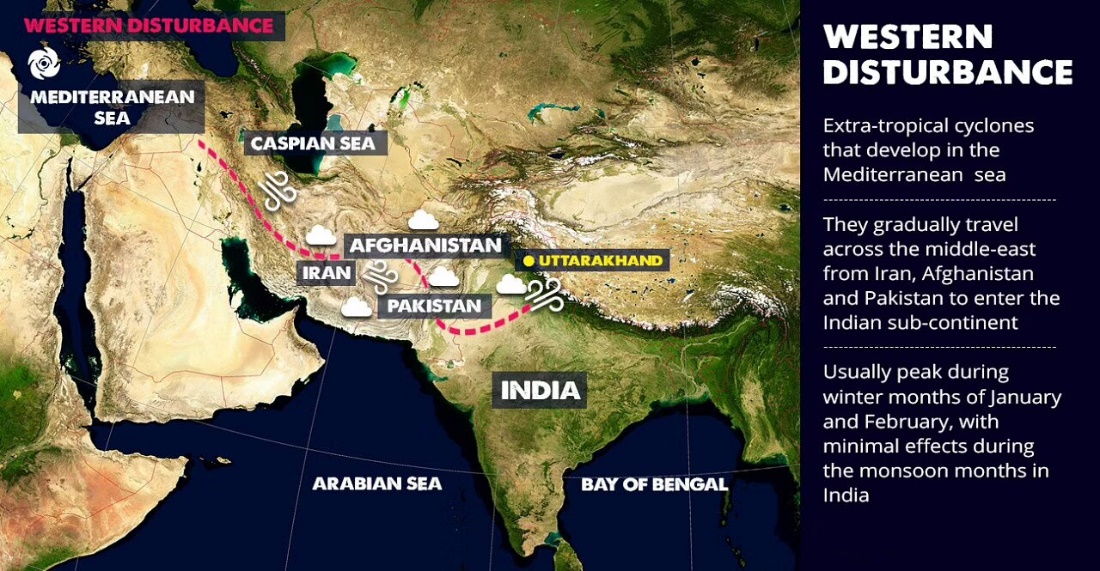- Filter By :
- Geography
- History
- Indian Heritage & Culture
- Indian Society
-
Q. What do you understand by western disturbances? Discuss their role in influencing climate in India. Discuss (150 words)
26 Dec, 2022 GS Paper 1 GeographyApproach
- Start your answer by briefly explaining western disturbances.
- Discuss the mechanism of Western Disturbances.
- Discuss their role in influencing climate in India.
- Conclude accordingly.
Introduction
- The western cyclonic disturbances are weather phenomena of the winter months brought in by the westerly flow from the Mediterranean region.
- The word 'Western' refers to the direction from which they originate with regard to India.
- The word 'disturbance' is used because the air within the low-pressure systems tends to be unstable or disturbed.
- They are extratropical storms that bring winter rain to the northwestern parts of the Indian subcontinent.
- They gradually travel across the middle-east from Iran, Afghanistan and Pakistan to enter the Indian sub-continent.
Body
- Mechanism:
- Origin: During winters, a high-pressure system develops in the regions around Ukraine which causes the cold air from polar regions to collide with the relatively warm and moist air at lower/temperate latitudes.
- The warm air mass is usually a part of the westerlies and carries a lot of moisture. When the two air masses at different temperatures meet, a front is formed.
- Eastward movement towards India: The formation of a front leads to cloud formation and heavy rainfall in areas coming under the influence of the frontal activity. This leads to formation of temperate cyclones in the upper atmosphere.
- At such heights, these cyclones come into contact with the subtropical westerly jet stream which carries them eastwards.
- In the course of its travel, the cyclone gathers moisture from the Caspian Sea and the Persian Gulf. It enters India mainly through the states of J&K, Punjab, Haryana, and Rajasthan.
- Origin: During winters, a high-pressure system develops in the regions around Ukraine which causes the cold air from polar regions to collide with the relatively warm and moist air at lower/temperate latitudes.
- Impact of Western Disturbance (WD):
- Indian Climate:
- A Western Disturbance is associated with rainfall, snowfall and fog in northern India. It arrives with rain and snow in Pakistan and northern India.
- The moisture which WDs carry with them comes from the Mediterranean Sea and/or from the Atlantic Ocean.
- WD brings winter and pre-monsoon rain and is important for the development of the Rabi crop in the Northern subcontinent.
- The WDs are not always the harbingers of good weather. Sometimes WDs can cause extreme weather events like floods, flash floods, landslides, dust storms, hailstorms and cold waves killing people, destroying infrastructure and impacting livelihoods.
- During the summer months of April and May, they move across North India and at times help in the activation of monsoon in certain parts of northwest India.
- During the monsoon season, western disturbances may occasionally cause dense clouding and heavy precipitation.
- Weak western disturbances are associated with crop failure and water problems across north India.
- Strong western disturbances can help residents, farmers and governments avoid many of the problems associated with water scarcity.
- Agriculture:
- An average of 4-5 western disturbances form during the winter season and the rainfall distribution varies in every western disturbance.
- Precipitation during the winter season has great importance in agriculture particularly for rabi crops including wheat, which is one of the most important Indian crops.
- The rainfall brought about by western disturbances have a direct impact on economies of wheat producing states like Haryana and Punjab.
- Weak western disturbances are even associated with crop failure and water problems across north India.
- Strong western disturbances can help residents, farmers and governments avoid many of the problems associated with water scarcity.
- Potential risk of Disaster:
- Unseasonable rainfall and hail brought about by western disturbances damages the crops in the North Indian states like Haryana, Punjab, Madhya Pradesh and Rajasthan.
- These storms also bring about lightning in areas affected by it. Recently, in Rajasthan, a number of casualties have been caused by lightning brought about by western disturbances.
- Natural disasters like cloudburst in Leh (2010), the Kashmir floods in 2014 and even 2013 floods in Uttarakhand were caused by the Western Disturbances.
- These calamities killed thousands of people and caused a lot of destruction in towns and cities situated on the bank of flooded rivers.
- Indian Climate:
Conclusion
Western Disturbances is a complex weather phenomenon and has profound impact on climate and agriculture of India. It is also a source of a number of natural disasters that occur every year in India causing huge loss of lives and property.
Thus, western disturbances need to be studied in much more detail. Like tropical cyclones or monsoon, there needs to be an end-to-end tracking of western disturbances to make it less hazardous.
To get PDF version, Please click on "Print PDF" button.
Print PDF






